Moon Leaves Evening to Dance with Morning Planets, Spotty Saturn, and We Take a Boo at Boötes!

This image of the Snowglobe Globular Star Cluster (aka NGC 5466) in Boötes simulates the view through a telescope at 132x. The area covered by the red circular viewport covers a bit more than the full moon’s size in the sky. On a dark night, the cluster can be seen as a faint fuzzy patch in binoculars and backyard telescopes. The cluster’s ~200,000 stars are clumped by their mutual gravity more than 50,000 light-years from our solar system.
Hello, End-of-May Stargazers!
Here are your Astronomy Skylights for the week of May 26th, 2024 by Chris Vaughan. Feel free to pass this along to your friends and send me your comments, questions, and suggested topics. You can also follow me on Twitter as @astrogeoguy! Unless otherwise noted, all times are expressed in Eastern Time. To subscribe to these emails please click this MailChimp link.
If you’d like me to bring my Digital Starlab portable inflatable planetarium to your school or other daytime or evening event in Simcoe, Grey, and Bruce Counties, or deliver a virtual session anywhere, contact me through AstroGeo.ca, and we’ll tour the Universe, or the Earth’s interior, together! My book with John A. Read entitled 110 Things to See With a Telescope is a guide to viewing the deep sky objects in the Messier List – for both beginners and seasoned astronomers. DM me to order a signed copy!
The moon will leave evening and spend this week in the morning sky, where it will wane in phase and pass several planets – some of which it will occult. While all the planets will rise in the east before the sun, only Saturn and Mars will be very visible. Mercury will be easier to see from the tropics, especially when it has a conjunction with Uranus on Friday. Meanwhile, Saturn’s moons, and/or their shadows, will be crossing Saturn from time to time. Finally, I share a detailed tour of Boötes’ stars that doesn’t require more than keen eyes. Read on for your Skylights!
The Moon
The moon will be missing from the evening sky worldwide this week, giving stargazers another opportunity to view late spring galaxies after dusk and the summer Milky Way in late night. If you are missing the moon, don’t fret – early risers can see our planet’s partner dancing with the planets before sunrise and then lingering into morning daylight like the ghost of the night.
Tonight (Sunday) the bright, waning gibbous moon will rise after midnight. It’ll be shining close to the dwarf planet Ceres, the largest body in the main asteroid belt, and just to the left of the teapot-shaped stars of Sagittarius (the Archer). Unfortunately, the moon’s 85%-lit beacon will outshine everything around it. Look for the moon in the lower part of the southern sky on your way to work or school.
With each passing day the moon will wane in phase and rise about 40 minutes later. It will spend Tuesday and Wednesday swimming with Capricornus (the Sea-Goat), and also staying in view until nearly lunch time.
The moon will spend Thursday and Friday among the stars of Aquarius (the Water-Bearer). When lunar phases occur on the first day or two of a calendar month, they can repeat at month-end. The moon will officially reach its third quarter phase (for the second time this month) at 1:13 pm EDT, 10:13 am PDT, or 17:13 Greenwich Mean Time on Thursday. At third (or last) quarter, the moon is always half-illuminated, on its western, sunward side.
Friday morning will also kick off the moon’s monthly cruise past the early morning planets. When the waning crescent moon rises in the southeast around 2:30 am local time on Friday morning, it will be accompanied by the yellowish dot of Saturn above it. The duo will be cozy enough to share the view in binoculars or a low power telescope. They’ll climb higher and move into the southeast until the brightening sky hides the ringed planet towards sunrise. The moon is far closer than Saturn. The farther south you are on Earth, the higher and closer to Saturn the moon will be. Around 07:00 GMT, observers in southern South America and across the Atlantic to equatorial Africa can watch the moon cross in front of (or occult) Saturn – albeit in daytime for the eastern regions of that event path. The occultation will be easy to see with sharp eyes, and in binoculars and backyard telescopes.

But wait – there’s more! On Saturday morning, the faint speck of the planet Neptune will be positioned several finger widths to the crescent moon’s upper right (or 3 degrees to its celestial west) – both of them in Pisces (the Fishes). Their separation will be close enough for them to share the view in binoculars, though blueish Neptune will be easier to see if you hide the bright moon just beyond the lower left edge of your binoculars. Saturn will shine off to their upper right. Hours earlier, observers with telescopes across southern Africa can watch the moon occult Neptune. Whether or not you have the means to see Neptune, the moon will be a pretty sight around sunrise, when Mars will shine down to its lower left, too.
To end this week, the old crescent moon will shine a palm’s width to the upper right (or celestial west) of the reddish planet Mars on next Sunday morning. Mars will rise to join the moon and Saturn after about 4 am. The pair of planets will remain visible until the brightening sky hides them. Due to the moon’s continuous motion around Earth, observers viewing the scene in westerly time zones will see the moon close enough to Mars for them to share the view in binoculars.
The Planets
Until Venus passes the sun at solar conjunction next week, all of the planets will be gathered in the eastern sky before sunrise. But only three of them will be readily observable. Venus will be beside the sun and invisible from Earth. Though Jupiter will be widening its separation from the sun, and will eventually become visible as a bright beacon in the predawn sky, it is still far too near the sun to be seen. Uranus is more than twice as far from the morning sun as Jupiter, but that that distant planet isn’t nearly bright enough to outshine the bright sky around it. So much for the highly touted morning planetary alignment I’ve been seeing on social media! That said, be patient. Lots of planets will put on a show in evening later this year. (Read on!)
For most of this week, three planets will be easily seen with your unaided eyes and binoculars until the brightening sky hides them – namely Saturn, Mars, and Mercury. A fourth planet, very faint Neptune, can be seen in good binoculars and backyard telescopes, if you know where to look. In the previous section, I discussed when the pretty, waning crescent moon will pose near those planets (and cross in front of some of them).

If you are willing to set the alarm and head out on a clear morning, the medium-bright, yellowish dot of Saturn will rise around 2:30 am local time and clear the rooftops in the east about an hour later. Reddish Mars will rise around 3:40 am. Mars will look a little brighter than Saturn. Far fainter, blue Neptune will be located about two-thirds of the distance along the line connecting Saturn and Mars, i.e., a fist’s diameter to the lower left (or 11° to the celestial east) of Saturn. This year, Neptune will be positioned a bit more than a thumb’s width to the upper left of a medium-bright star named 27 Piscium. They’ll share the view in binoculars. Other less-brilliant stars nearby named 29 Piscium, 24 Piscium, and 20 Piscium will help guide you to Neptune.
The outermost planet will become easier to see with each passing week. The slanted ecliptic, which expresses the plane of our solar system across the sky, is keeping all the planets low in the morning sky. As we get closer to the June solstice, the ecliptic will become more vertical and lift the planets with it. Furthermore, everything is rising about half an hour earlier per week due to our orbit around the sun. For example, on July 7, Saturn will start rising before midnight and Jupiter will join the evening sky from September 4 onwards. Like Saturn, Neptune will be a star-party target from late summer on.
Saturn’s rings, which will effectively disappear when they become edge-on to Earth next March, already appear as a very narrow slash across the planet’s globe. Good binoculars can hint at Saturn’s rings and any telescope will show them. For telescope-owners, Earth’s perspective of the Saturn system this year and next will produce frequent transits of Saturn’s moons and their black shadows across its disk. On Wednesday morning, the large moon Titan will cross Saturn’s south polar region from 3 am to 6:30 am PDT (i.e., in daylight for eastern North America). On Thursday, May 30, the shadow of Dione will cross the planet’s southern hemisphere from 2:57 to 5:35 am EDT. The tiny shadow of Saturn’s moon Enceladus will cross the planet south of the ring plane on Friday, May 31 from 3:39 to 6:05 am EDT.
In a telescope, Mars’ position on the far side of the sun from Earth will keep the planet looking small.
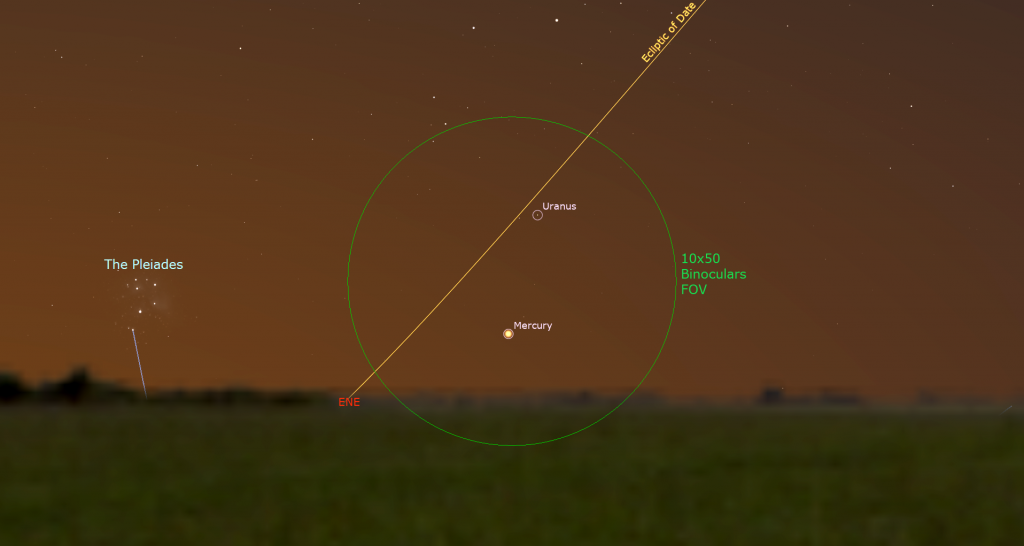
Observers who have unobstructed views to the east-northeast might be able to spot Mercury shining just above the horizon before sunrise this week. The speedy planet will be heading back toward the sun every morning so the viewing opportunity is closing. Turn all optics away from the eastern horizon before the sun rises. On Friday morning, observers viewing from tropical latitudes can use binoculars or a backyard telescope to reveal 440-times-fainter Uranus positioned a thumb’s width to Mercury’s upper left (or 1.3 degrees to the celestial north). The stars of the Pleiades cluster aka Messier 45 sprinkled a palm’s width to the left of those two planets should show in binoculars, too.
Late-May Moonless Stargazing
Though the night sky will be moonless this week, it also won’t get truly dark until almost 11 pm at mid-northern latitudes. If you are nevertheless up for some late-night observing, I described the best slate spring dark sky delights at http://astrogeo.ca/mars-and-bright-jewels-crown-venus-in-evening-and-the-moons-move-to-morning-gives-galaxies-again/! Most of the same objects will still be descending the western sky after dusk this week. If you don’t have the equipment to chase after distant galaxies, read on for a guided tour of the stars of Boötes (the Ploughman). It only needs you to head out and look up with your unaided eyes or everyday binoculars.
Taking a Boo at Boötes
The mild temperatures and moonless evening skies this week offer a fine opportunity to explore the realm of Boötes (“Bow-OH-tees”), the Herdsman or Ploughman.
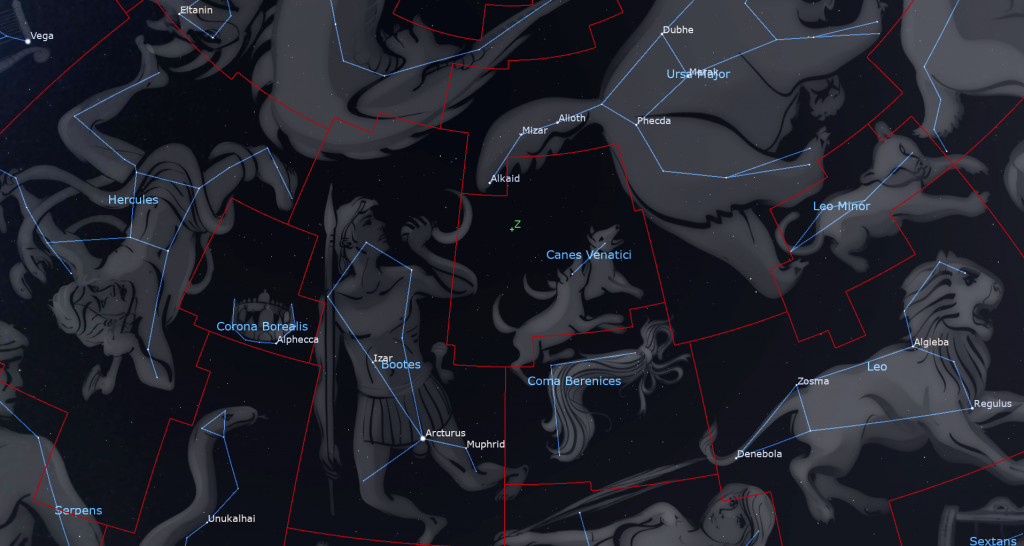
As the sky darkens after 10 pm local time face southeast and look two-thirds of the way up the sky for the very bright, orange-tinted star named Arcturus (or Alpha Boötis). The fourth brightest star in the entire night sky, and a “neighbour” of our sun at a mere 37 light-years away, Arcturus means “Guardian/Watcher of the Bear” in Greek, because it always rises after Ursa Major (the Big Bear), which sits above it (celestial west) this month. Arcturus shines with that colour because it is just passing middle-age for a star, starting towards the red supergiant stage.
The entire ploughman constellation is visible from everywhere on Earth except Antarctica. In Chinese, Arcturus is known as Dà Jiǎo Xīng 大角星, “Great Horn Star”, part of the huge Azure Dragon of the East asterism, which stretches from Boötes and Virgo on the west to Scorpius and Sagittarius on the east. The star Antares marks the dragon’s heart. I’ll post a Chinese star chart here.
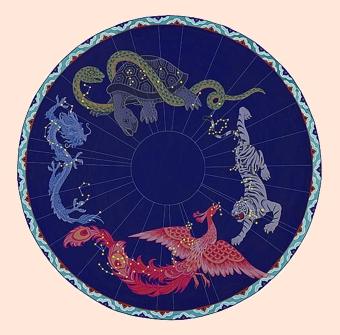
Arcturus anchors the bottom tip of a large, kite-shaped asterism within the larger constellation of Boötes. The rest of the stars in the kite are bright enough to be visible under somewhat light-polluted skies and under any skies through binoculars. The kite measures 2.3 fist diameters on the long axis and a fist’s width across at its widest point. During spring evenings at mid-northern latitudes the kite extends upwards to the left from Arcturus. The full figure of Boötes strides over the ecliptic and the celestial equator, with his widely spaced feet stars closest to those two imaginary lines. The ecliptic and equator circles intersect in Virgo (the Maiden), about three fist diameters to Arcturus’ lower right (or 32° to the celestial southwest).
Virgo (the Maiden) occupies the sky to the lower right (south of) Boötes and the sinuous constellation of Draco (the Dragon) is to the upper left (north) of him. The ploughman is bordered on his left (celestial east) by Corona Borealis (the Northern Crown) and Hercules. His right-hand (westerly) neighbours are Coma Berenices (Berenice’s Hair) and Canes Venatici (the Hunting Dogs).
In May and June, Ursa Major and its Big Dipper asterism is located above Boötes. In late summer the dipper drops to his right. Even when Boötes’ stars shine before dawn, he still follows the dipper’s handle stars across the sky. It’s likely that the Ploughman moniker refers to the Big Dipper’s other name, the Plough.
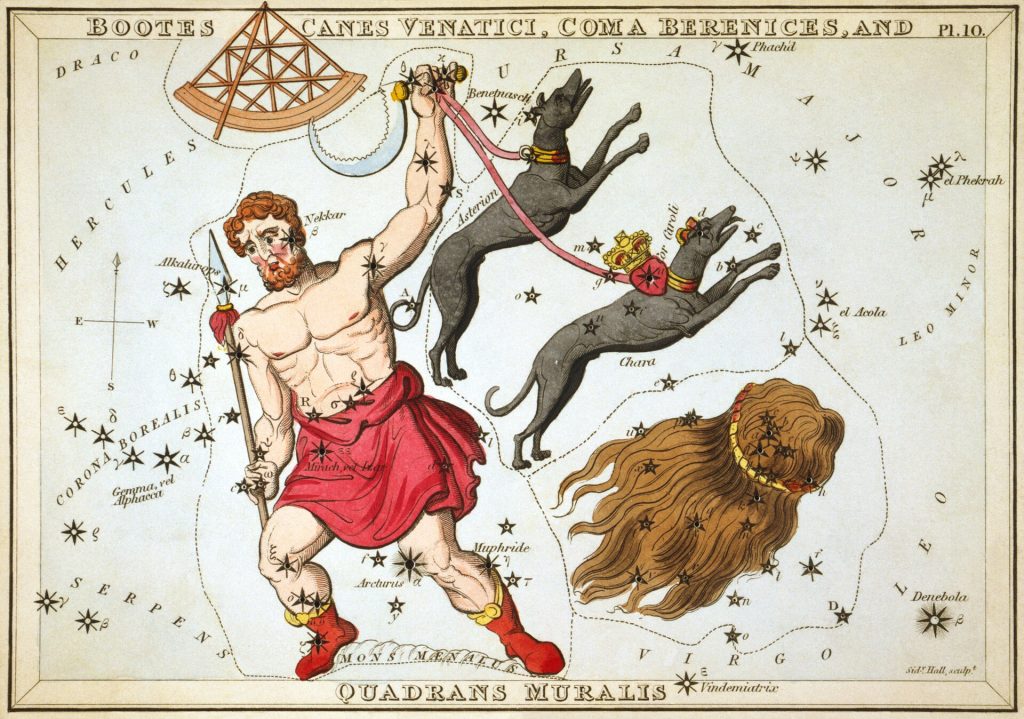
Let’s tour Boötes’ stars. A widely separated pair of medium-bright stars shine a fist’s diameter to Arcturus’ upper left (or celestial NNE). The lower, brighter one is Izar (ε Boötis), meaning “Loin Cloth”. (The word Boötis is Latin for “belonging to Boötes”. We’ll use “Boo” to shorten things.) The name Izar resembles Mizar, the star at the bend in the Big Dipper’s handle. That star also serves as a loin – but of the bear.
A faint star named 34 Boo sits just half a finger’s width towards Arcturus from Izar. In a telescope, Izar itself splits into a gorgeous double star – with one partner golden and the other star white, or greenish, and tucked in very close to it. Those two companions are orbiting one another in a true binary star system some 200 light-years from our sun. A few finger widths to the upper right of Izar, on the upper (western) side of the kite, you’ll see a medium-bright star designated Rho Boötis (ρ Boo). This star marks the herdsman’s western hip. See if you can see a small star on the Izar side of Rho. That’s Sigma Boötis (σ Boo), a sunlike star 50 light-years away from us.
Making a jump about twice as far from Arcturus along the line drawn through Izar brings us to the herdsman’s eastern shoulder, a medium-bright star designated Delta Boötis (δ Boo) or Thiba, a yellowish G8-class, sun-like star about ten times more massive than our sun. Thiba is located 117 light-years away from our solar system.
A star named Nekkar “the Ox Driver” shines a generous palm’s width above (or 7.5° to the celestial northwest) of Thiba. Nekkar (or β Boo) marks the herdsman’s head and the top of the kite. Nekkar was originally a blue star. It’s now aging through a phase that is causing it to temporarily resemble a large version of our sun – on its way to becoming a brighter, red giant star.
A medium-bright, triple star named Alkalurops (or Mu Boo), a name derived from “Shepherd’s Staff”, sits about four finger widths to the upper left (or 4.5° to the celestial northeast) of Thiba. It forms a squat triangle with Thiba and Nekkar. Two of Alkalurops’ stars can be discerned with sharp eyes or binoculars, and one of them splits into two stars when viewed through a telescope. All three stars are orbiting one another in a dance that takes at least 125,000 years for one orbit. Before moving on, position Alkalurops towards the right side of your binoculars’ field of view and look on the left for two close together stars named Nu Boötis or v1 and v2 Boo. They have dramatically different colours!
Above and between Nekkar and Rho Boo shines a bright star named Seginus or Gamma Boötis (γ Boo), which marks the herdsman’s western shoulder. Seginus is a white giant star that is evolving towards becoming a red giant one day. This 85 light-years-distant star is spinning about 70 times faster than our sun, which revolves once per month.
The medium-bright stars positioned to the lower right (celestial south) of Arcturus form the herdsman’s legs and feet. The left (eastern) foot, which sits less than a fist’s diameter below Arcturus, is designated Zeta Boötis (ζ Boo). In a telescope at high power it is revealed to be a nice, matched pair of close-together white stars. The medium-bright stars shining two finger widths to the upper left (northeast) of Zeta are whitish Pi Boo (on the right), which is another nice double star, and yellowish Omicron Boo (on the left). Double their distance to the fainter double star Xi Boötis (ξ Boo).
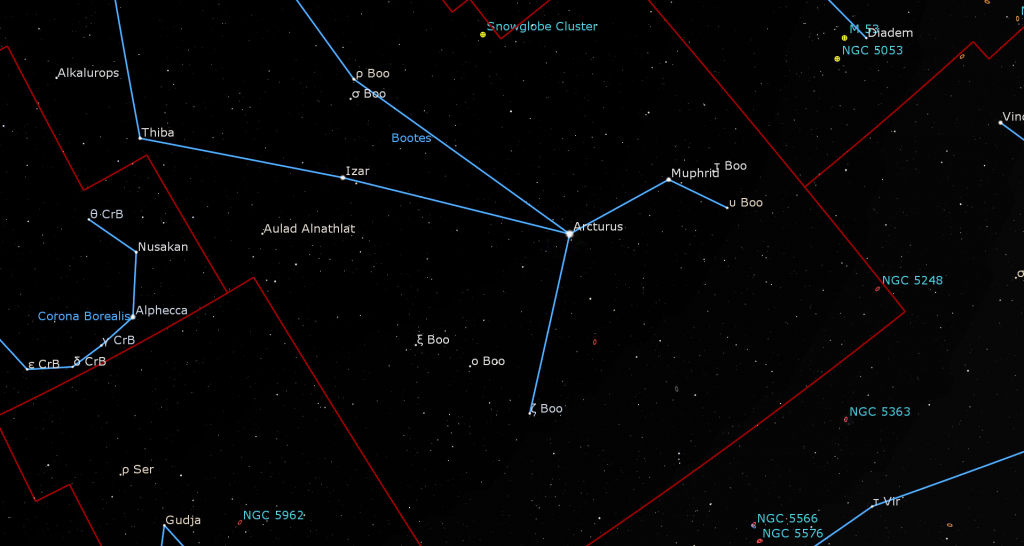
Moving about four finger widths to the upper right from Arcturus, along Boötes’ western leg, brings us to the bright star Muphrid or Eta Boötis (η Boo), meaning “the Solitary star of the Lancer”. Murphrid too, has a composition similar to our sun. Even though it is actually the same distance away from us as Arcturus, its inherent brightness is lower, so it appears much dimmer in the sky. Dropping down slightly and moving farther to the right brings us to Upsilon Boötis (υ Boo), a very distant red giant star.
All the stars within our galaxy are in motion, jostling about as they orbit the galactic centre every quarter of a billion years or so. Some stars move faster, or are located closer to us – so they exhibit a greater apparent motion compared with the surrounding stars. Astronomers call this phenomenon proper motion. That’s why star charts need to be updated about every ten years. Arcturus has a very high proper motion southward. In a few thousand years, the herdsman’s legs will be bent upwards with Arcturus below his knees!
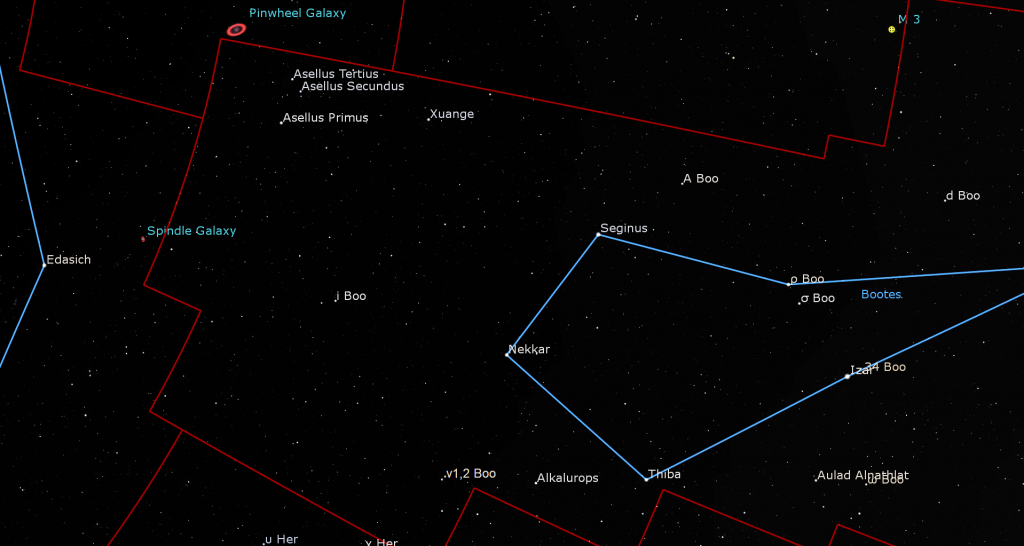
Boötes’ territory extends almost to the tip of the Big Dipper’s handle. A palm’s width below the bright star Alkaid at the tip of the handle, look for a tight grouping of three stars that represent the herdsman’s upraised hand. Their names are Asellus Primus, Asellus Secundus, and Asellus Tertius (Theta, Iota, and Kappa Boo), the “First, Second, and Third Donkey”. The two higher (westerly) donkeys are telescopic double stars. The area around all three is a lovely, rich field for viewing because it’s full of small galaxies. The famous and easy-to-see Pinwheel Galaxy (Messier 101) is located only a few finger widths to the left (celestial north) from them!
Positioned well off the Milky Way, Boötes hosts rather few bright deep sky objects. A palm’s width to the upper right (or 6 degrees to the celestial southwest) of Rho Boötis sits the globular star cluster known as the Snowglobe Cluster (or NGC 5466). It will appear as a small, fuzzy patch in binoculars and backyard telescopes under a dark sky. A further palm’s width to the upper right (or 5° to the celestial west) of the snowglobe, in next-door Canes Venatici (the Hunting Dogs), is the magnificent and much brighter globular cluster named Messier 3 – an easy object for urban stargazers. The constellation does host a great many faint, distant galaxies. One worth checking out is the terrific, magnitude 11 spiral galaxy NGC 5248, also known as Caldwell 45. It’s located in the southwestern corner of the constellation. Take the line drawn from Murphrid to u Boo and quadruple it.
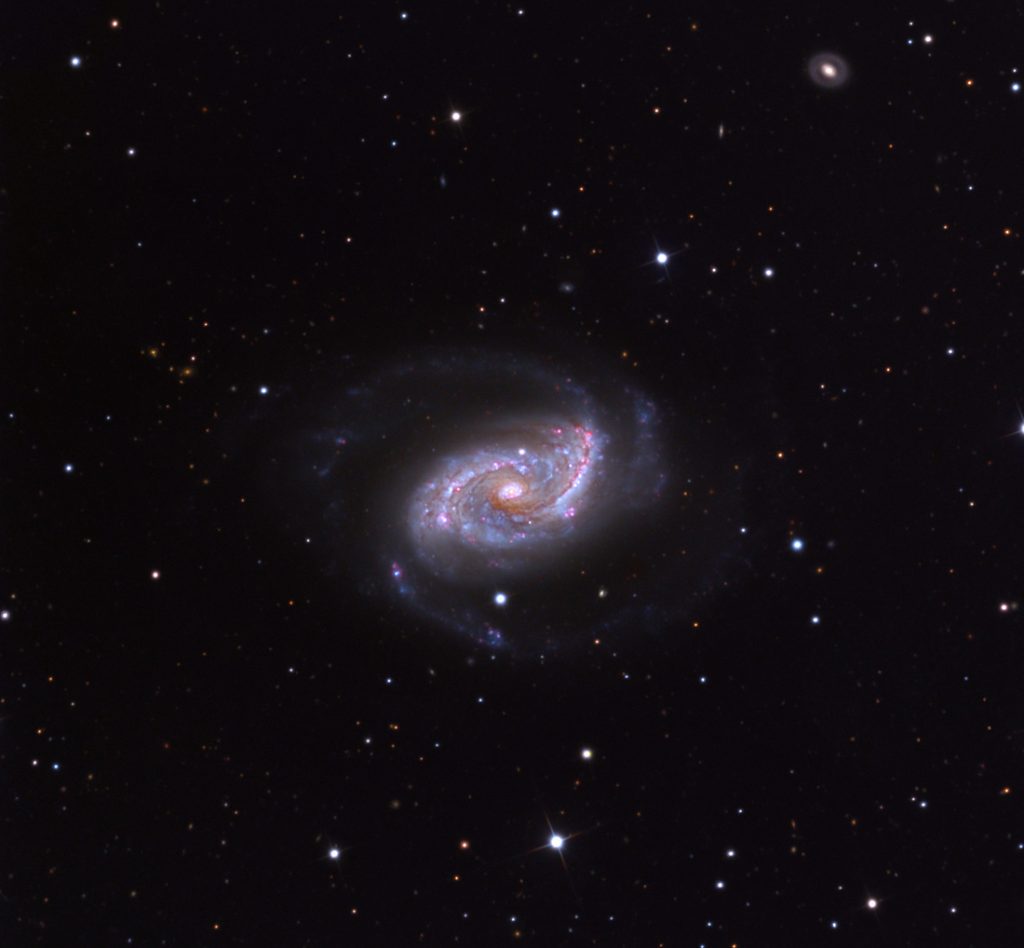
Use your binoculars to seek out a short chain of 6 and 7 magnitude stars located below and between the herdsman’s feet. That kite’s string dangles towards the celestial equator and the bright star Spica below it!
Public Astronomy-Themed Events
Every Monday evening, York University’s Allan I. Carswell Observatory runs an online star party – broadcasting views from four telescopes/cameras, answering viewer questions, and taking requests! Details are here. They host in-person viewing on the first clear Wednesday night each month. Other Wednesdays they stream views online via the observatory YouTube channel. Details are here.
On Saturday, June 1 from 10 am to noon, you can try out Solar Observing at the Ontario Science Centre! If it’s sunny, members of the RASC Toronto Centre will be setting up outside on the Teluscape in front of the main doors. They’ll have an array of special equipment designed to view the Sun safely. This is free to the public, but parking and admission fees inside the Science Centre will still apply. Check the RASC Toronto Centre website or their Facebook page for the Go or No-Go notification.
Keep your eyes on the skies! I love getting questions and requests. Send me some!